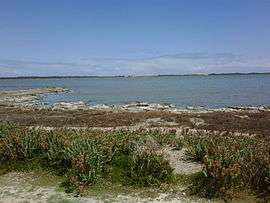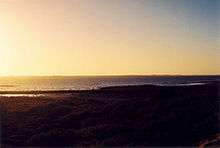Coorong National Park
| Coorong National Park South Australia | |
|---|---|
|
IUCN category II (national park) | |
 The Coorong looking across its midpoint near Salt Creek | |
 A map of the Coorong | |
 Coorong National Park | |
| Nearest town or city | Goolwa |
| Coordinates | 36°02′57″S 139°33′13″E / 36.04917°S 139.55361°ECoordinates: 36°02′57″S 139°33′13″E / 36.04917°S 139.55361°E |
| Established | 1 January 1966[1] |
| Area | 489.91 km2 (189.2 sq mi)[1] |
| Managing authorities | Department of Environment, Water and Natural Resources |
| Website | Coorong National Park |
| See also | Protected areas of South Australia |
The Coorong National Park is a protected area located in South Australia about 156 kilometres (97 mi) southeast of Adelaide and that pre-dominantly covers a lagoon ecosystem officially known as the Coorong and the Younghusband Peninsula on the Coorong's southern side.
Etymology
Its name is thought to be a corruption of the local Aboriginal people's word kurangh, meaning "long neck"; a reference to the shape of the lagoon system. The name is also thought to be from the Aboriginal word Coorang, "sand dune", a reference to the sand dunes that form the Younghusband Peninsula.
Description
The western end of the Coorong lagoon is at the Murray Mouth near Hindmarsh Island and the Sir Richard Peninsula, and it extends about 130 kilometres (81 mi) southeast. The park area includes the Coorong itself, and Younghusband Peninsula which separates the Coorong from Encounter Bay in the Southern Ocean. The Coorong has been cut off from Lake Alexandrina by the construction of the Goolwa Barrages (weirs) from Goolwa to Pelican Point during the late 1930s.[2]
The park was formed in 1966 as a sanctuary for many species of birds, animals and fish. It attracts many migratory species. It provides refuge for these animals during some of Australia's regular droughts. The 467 square kilometres (180 sq mi) also supports coastal dune systems, lagoons and coastal vegetation.[3]
One of the unique aspects of the Coorong is the interaction of water along its length, with sea water and Murray River water meeting rainfall and groundwater. The freshwater supports the fauna (animal) of the area while the sea water is the habitat for much of the birdlife.[4]
The waters of the Coorong are a popular venue for recreational and commercial fishers. The popular 'Coorong Mullet' and 'school mulloway' are the main species. The region was the setting of the popular 1977 film Storm Boy.
Birds
The Coorong National Park has been recognised by BirdLife International as an Important Bird Area. It has supported the chestnut teal, Australian shelduck, sharp-tailed sandpiper, red-necked stint, banded stilt, red-necked avocet, pied oystercatcher and red-capped plover. Australasian bitterns have been recorded. It has also supported significant numbers of orange-bellied parrots, fairy terns and hooded plovers, although their usage of the site has declined from reduced freshwater inflows.[5]
Notable events
In 1840, the brigantine Maria was shipwrecked near Cape Jaffa after leaving Port Adelaide.[6] All 25 people aboard were massacred by Aborigines along the Coorong.[6]
In February 2013, a lifeboat from MS Oliva, that foundered in the south Atlantic, washed up on a beach in the Coorong.[7] Images of Oliva with the lifeboat rails empty can be seen at the Tristan da Cunha website of the grounding and recovery.
Gallery
 Sunset over the northern part of The Coorong, approaching the town of Meningie, South Australia.
Sunset over the northern part of The Coorong, approaching the town of Meningie, South Australia. The punitive expedition to the Coorong after the massacre of survivors of the wreck of the Maria, August 1840.
The punitive expedition to the Coorong after the massacre of survivors of the wreck of the Maria, August 1840.- Flock of banded stilts on sand flats at the Coorong.
- View of the Coorong and Younghusband Peninsula.
- Entrance to The Coorong (mid-distance) looking from Hindmarsh Island
See also
- Protected areas of South Australia
- Coorong (disambiguation)
- List of islands within the Murray River in South Australia
References
- 1 2 "CAPAD 2012 South Australia Summary (see 'DETAIL' tab)". CAPAD 2012. Australian Government – Department of the Environment. 6 February 2014. Retrieved 6 February 2014.
- ↑ Map of the Coorong Accessed 3/3/7
- ↑ Coorong National Park – Things to see and do, Accessed 30/7/9
- ↑ Coorong National Park – Natural Attractions, Accessed 30/7/9
- ↑ "Important Bird Areas factsheet: Coorong". BirdLife International. 2016. Retrieved 3 December 2016.
- 1 2 "A Famous Wreck". The Evening News. Sydney: National Library of Australia. 5 October 1895. p. 1 Supplement: Evening News Supplement. Retrieved 29 May 2013. This reference quite credibly states the bodies were stuffed down wombat holes, where others coyly refer to "shallow graves". It is also one of the few to touch on the contentious possibility of cannibalism.
- ↑ Shipwreck lifeboat washes up in Australia, ABC News Online, 6 February 2013
External links
![]() Media related to Coorong National Park at Wikimedia Commons
Media related to Coorong National Park at Wikimedia Commons